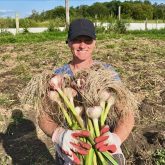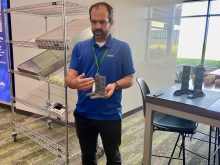The recession has actually helped Canada’s largest packet seed company and the local-food trend and food scares are also boosting business.
“We have noticed that there has been an increased interest in gardening in the last couple of seasons, which may be attributed to the uncertain economy and contributing factors such as food safety,” said McKenzie Seeds plant manager Don Storey.
Storey now oversees a new plant, a low-slung large white building alongside the railway tracks, and across from the auction mart and the Co-op feed mill. Its former digs, the iconic red brick building that towers over the city’s downtown on Ninth Street, is now being converted into apartments featuring high ceilings and stunning views of the city and surrounding prairie.
Read Also

Manitoba canola industry has new frontiers
Canola oil is still the main priority for the sector, but canola meal is increasingly the subject of research looking for new markets and uses for the oilseed’s byproduct.
NEW LOCATION
The new location – and the growing sales – underscore the vision of founder A. E. McKenzie, who started the company in 1896 after correctly foreseeing there were huge profits to be made by buying seed in large bags and then selling it in small packets to the settlers pouring on to the Prairies.
With 150 unionized employees, McKenzie Seeds is one of the larger employers in Brandon, after Maple Leaf Foods on the east side of the city. McKenzie Seeds was bought a few years ago by Jiffy Group (the Norwegian multinational that makes peat pots for starting seedlings). Storey estimates the company holds a roughly 65 per cent market share in the Canadian retail seed market via a handful of brand names.
Along with saving a bit of money on the food budget while getting some sunshine and exercise, many health-conscious consumers are taking up gardening because the food is pesticide free and as fresh as the day they picked it.
The company offers a range of different brands that are packaged to appeal to various consumer segments, from the epicurean foodie crowd that craves the distinct flavours of exotic Italian and Asian vegetables, to the price-conscious shoppers at Dollarama and Walmart, who just want to plant basic garden-variety lettuce, carrots and corn to round out their summer diet.
BROAD APPEAL
Brands with cartoon labels are also included to appeal to kids – and parents who may want to get their kids hooked on gardening and eating healthy foods from an early age.
Some perishable goods, such as trees, bulbs and other live garden products, are sourced from local wholesalers such as the nursery in Portage.
But most of the seed comes in hefty 25-kilogram bags shipped in from large-scale producers around the world, mainly from the United States and Europe, according to Ann Farguson, who led visitors from the 22nd annual Rural Policy Conference on a tour. (The conference is put on by Brandon University’s Rural Development Institute.)
Hopper-fed machines run by a single operator take various seed types from large, bulk bags, measure the amounts automatically and place them in hundreds of small packets per hour. The packets are put inside large cardboard displays by workers further down the assembly line, then stored in the large warehouse prior to shipping. The displays make it easy for retailers to open them up and place them in their seasonal display areas come spring.
BUSY TIMES
Fall is a busy time of year, because many large retail chains want to have stock on hand as early in the new year as possible.
Seed is tested for germination success and purity by the operation’s own in-house lab, said Sharla Kanski, a senior seed analyst.
“All the seed is either tested ahead of time or once it comes in the building,” said Kanski, who works in a small lab equipped with ample counter space, numerous microscopes, and a germination cabinet that simulates both soil temperatures, as well as length of daylight.
McKenzie must comply with Canadian Food Inspection Agency standards, which set minimum tolerances for weed seeds, both of the common and noxious variety.
The government also requires seed lots have a minimum germination rate, but McKenzie sets its own standard at a rate at least five per cent higher, she said.
“It could be 70 to 85 per cent, so we shoot for 80 to 90, which is not uncommon in beans, peas and corn, for sure,” she said. “And then a lot of the vegetables, like brassicas, would maintain those high numbers. I just took off some broccoli the other day that was 99 per cent.”
Seeds are wetted and then rolled up in wet blotter paper to count germination percentages as well as detect abnormalities, such as geotropism, where roots grow upside down.
Seed suppliers have to be very careful about quality. If a sample is found to contain noxious weeds, it is sent back to the source. [email protected]
———
“Wehavenoticedthattherehasbeen anincreasedinterestingardeninginthe lastcoupleofseasons,whichmaybe attributedtotheuncertaineconomyand contributingfactorssuchasfoodsafety.”
– Don Storey


















